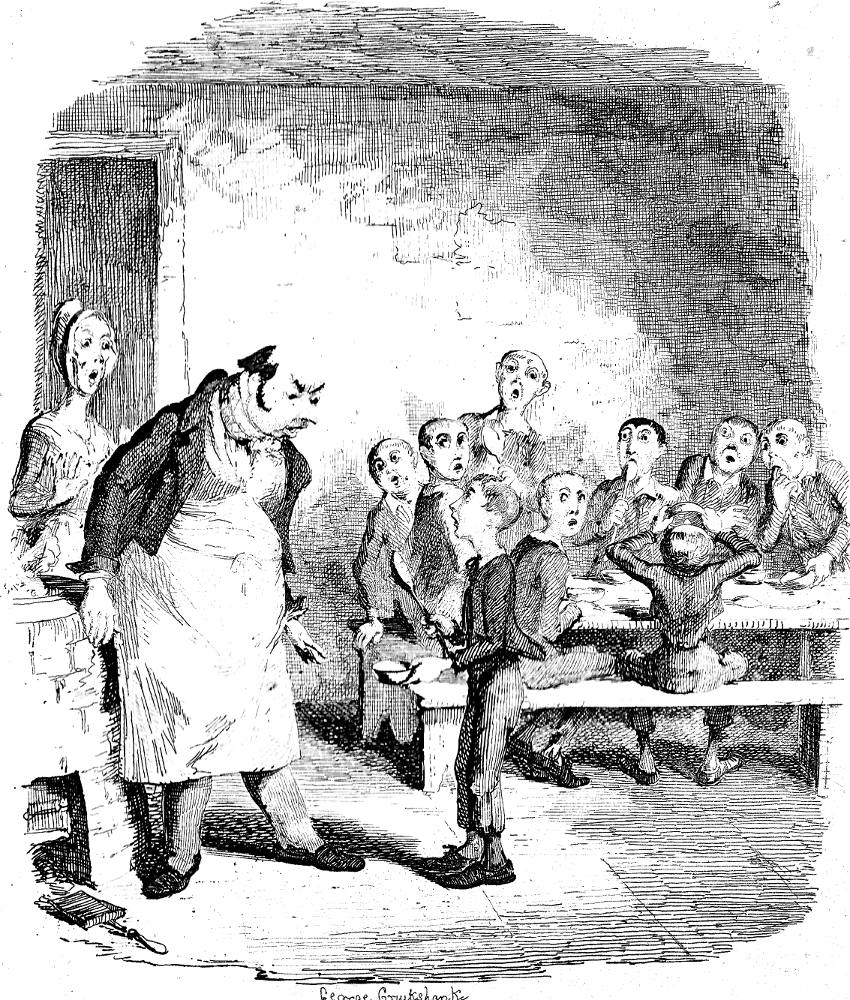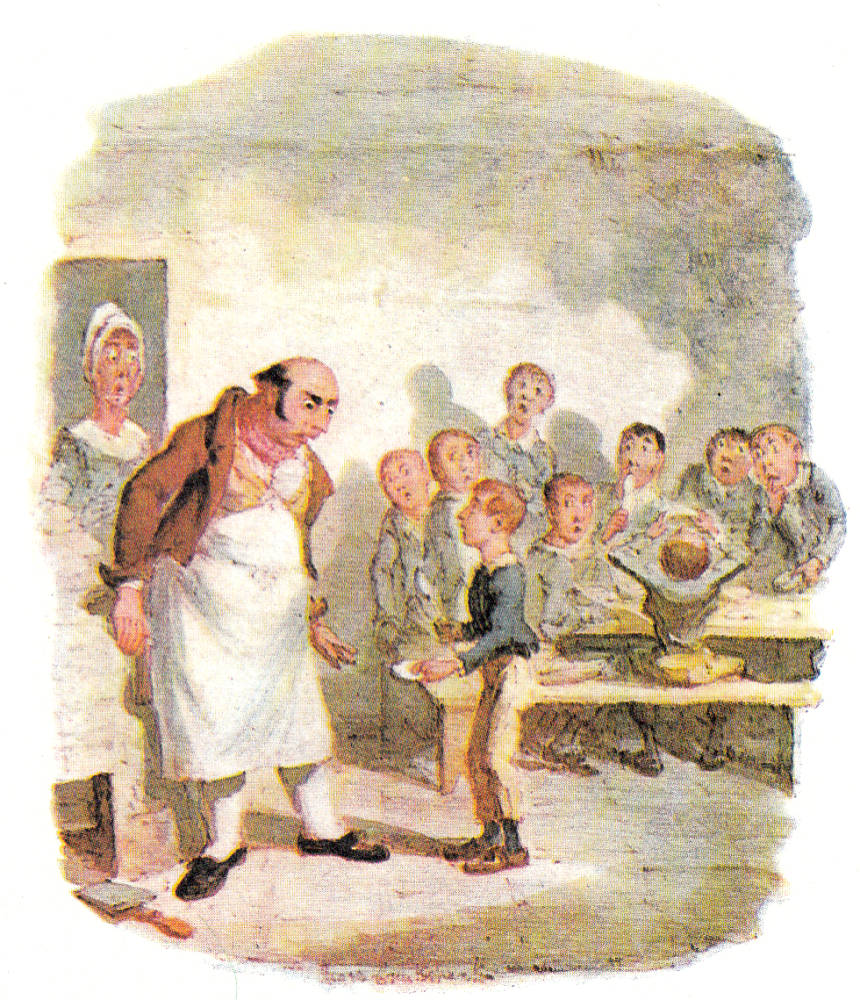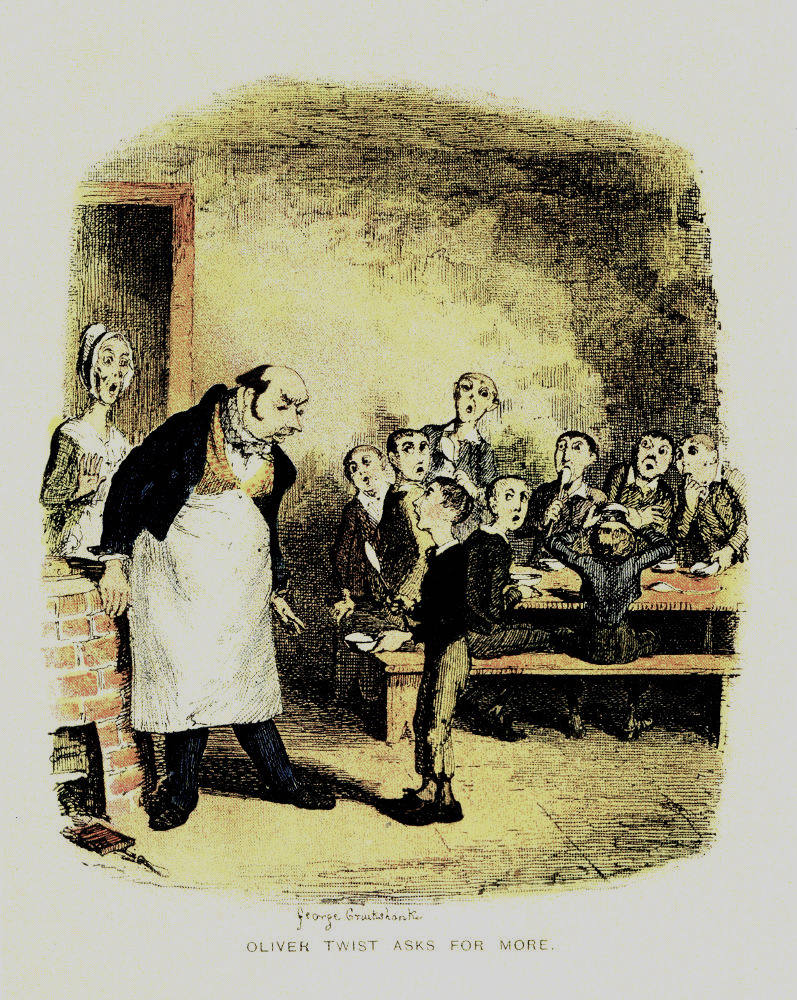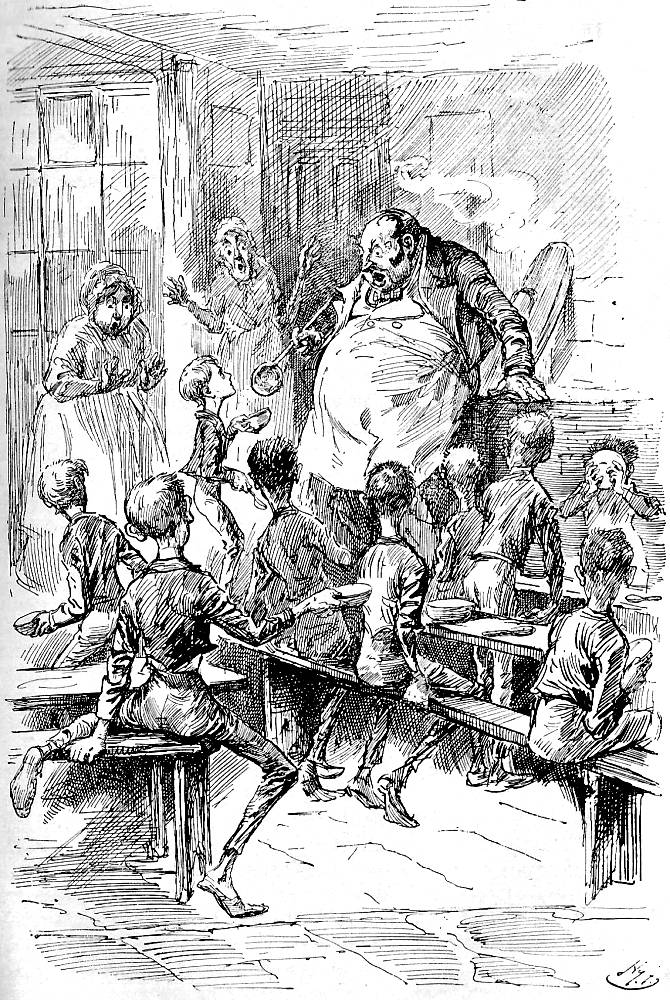

Oliver asking for more! (frontispiece in the 1846 edition) — initial steel engraving and later watercolour for Charles Dickens's The Adventures of Oliver Twist; or, The Parish Boy's Progress, first published in volume by Richard Bentley after its February 1837 appearance in Bentley's Miscellany, Chapter II. 4 ½ by 3 ¾ inches (11.3 cm by 9.4 cm), vignetted, facing title-page. Cruikshank's own 1866 watercolour, commissioned by F. W. Cosens, is the basis for the 1903 chromolithograph. [Click on the images to enlarge them.]
- Title-page and frontispiece
- George Cruikshank's coloured Illustrations from 1911 Collector's Edition of Oliver Twist
Passage Illustrated: Oliver Asserts Himself — "Please, sir, I want some more."
For the first six months after Oliver Twist was removed, the system was in full operation. It was rather expensive at first, in consequence of the increase in the undertaker's bill, and the necessity of taking in the clothes of all the paupers, which fluttered loosely on their wasted, shrunken forms, after a week or two's gruel. But the number of workhouse inmates got thin as well as the paupers; and the board were in ecstasies.
The room in which the boys were fed, was a large stone hall, with a copper at one end: out of which the master, dressed in an apron for the purpose, and assisted by one or two women, ladled the gruel at mealtimes. Of this festive composition each boy had one porringer, and no more — except on occasions of great public rejoicing, when he had two ounces and a quarter of bread besides.
The bowls never wanted washing. The boys polished them with their spoons till they shone again; and when they had performed this operation (which never took very long, the spoons being nearly as large as the bowls), they would sit staring at the copper, with such eager eyes, as if they could have devoured the very bricks of which it was composed; employing themselves, meanwhile, in sucking their fingers most assiduously, with the view of catching up any stray splashes of gruel that might have been cast thereon. Boys have generally excellent appetites. Oliver Twist and his companions suffered the tortures of slow starvation for three months: at last they got so voracious and wild with hunger, that one boy, who was tall for his age, and hadn't been used to that sort of thing (for his father had kept a small cook-shop), hinted darkly to his companions, that unless he had another basin of gruel per diem, he was afraid he might some night happen to eat the boy who slept next him, who happened to be a weakly youth of tender age. He had a wild, hungry eye; and they implicitly believed him. A council was held; lots were cast who should walk up to the master after supper that evening, and ask for more; and it fell to Oliver Twist.
The evening arrived; the boys took their places. The master, in his cook's uniform, stationed himself at the copper; his pauper assistants ranged themselves behind him; the gruel was served out; and a long grace was said over the short commons. The gruel disappeared; the boys whispered each other, and winked at Oliver; while his next neighbours nudged him. Child as he was, he was desperate with hunger, and reckless with misery. He rose from the table; and advancing to the master, basin and spoon in hand, said: somewhat alarmed at his own temerity:
"Please, sir, I want some more."
The master was a fat, healthy man; but he turned very pale. He gazed in stupified astonishment on the small rebel for some seconds, and then clung for support to the copper. The assistants were paralysed with wonder; the boys with fear.
"What!" said the master at length, in a faint voice.
"Please, sir," replied Oliver, "I want some more." [Chapter II, "Treats of Oliver Twist's Growth, Education, and Board," pp. 9-10]
Commentary: An Iconic Image of Social Protest

Left: Oliver Twist Asks for More, chromolithograph in Oliver Twist (London: Caxton, 1910): 4 ¼ by 3 ¾ inches (19.4 cm high by 9.4 cm wide), vignetted frontispiece, facing title-page.
By now, the confrontational scene in the workhouse refectory in the initial (February 1837) number of The Adventures of Oliver Twist; or, The Parish Boy's Progress is familiar even to non-English speakers as a result of dramatisations, television adaptations, films, and even such cartoons as Oliver Asks for a Doggy Bag, even though few would identify it with an obscure Victorian periodical entitled Bentley's Miscellany. Here the novel first appeared in twenty-four monthly instalments, each with a single-page steel engraving by caricaturist George Cruikshank.
Born in the workhouse where his mother died shortly after childbirth, for all but the first of the first nine years of life Oliver has been raised in Mrs. Mann's baby farm. However, on his ninth birthday, under Bumble's tutelage, Oliver returns to the workhouse in order to "learn a useful trade" (picking oakum, in fact), if he does not succumb to the workhouse regimen, which tends to starve boys to death. In this celebrated scene, a rake-thin Oliver holds centre stage as the spokesman for the famished inmates, his role forced upon him through the drawing of lots. The overfed "master" scowls at the temerity of the scrawny waif, while the eight other survivors of the starving system look on in suspense, and the matron expresses utter astonishment (left rear).

Kyd (Clayton J. Clarke) in his Player's Cigarette Cards series Characters from Dickens depicts the same moment in the text: No. 4. Oliver (1910), but removes the social context, the Master of the Parish Workhouse administering the small meal to the starving boys under his charge (chromolithograph).
Because Cruikshank's initial illustration had achieved iconic status, Dickens's publishers chose to use it from Bentley's Miscellany for the frontispiece for the single-volume edition. Even prior to the completion of its serial run in April 1839, the enterprising Richard Bentley had published the novel as a triple-decker in November 1838 to capitalise on the magazine serial's popularity. In the Cruikshank illustration, Oliver achieves the status of hero through standing up not merely for himself, but for his fellow inmates, all of whom are being subjected to abuse, neglect, and malnutrition. Thus, the picture remains in our memory, just as Rodin's Le Penseur remains in the mind's eye as a symbolic pose. What Cruikshank's engraving signifies is Dickens's protest against all the ills of early Victorian society, but especially its unjust and neglectful treatment of unwanted working-class orphans, many of them illegitimate, as Hasan notes:
In Victorian England an illegitimate child was filis nullius, or the child of no one, and therefore "had no automatic right to inherit their parents' property," and the same "filius nullius logic was extended by the New Poor Law of 1834 to the right of an unwed mother to obtain support for her child from the putative father" (Abramowicz 43). Thus the non-identity and non-recognition of nonmarital children like Oliver severely affected them both socially and financially, and characterized them as a tremendous economic and social burden on society in Victorian England. [Hassan 18]
Such non-persons were, of course, regarded as disposable, as Oliver's being apprenticed to a chimney-sweep suggests. Unwanted children like this one might escape the early death of a chimney-sweep's boy by becoming street criminals, practising petty theft and in particular pick-pocketing to survive. What awaited most such escapees of the Work House was ultimately Australian transportation or the noose.
Illustrations from the Household (1871) and the Charles Dickens Library Edition (1910)


Left: Harry Furniss's Charles Dickens Library Edition illustration (1910) Starvation in the Workhouse. Right: James Mahoney's Household Edition frontispiece (1871) bears a strong resemblance to the original version of Oliver's Asking for More, uncaptioned headpiece for chapter one. [Click on the images to enlarge them.]
Related Material
- Depictions of Bumble, the Parish Beadle from Oliver Twist and other Beadles
- Oliver Twist as a Triple-Decker
- Oliver untainted by evil
- Like Martin Chuzzlewit, it agitates for social reform
- Oliver Twist Illustrated, 1837-1910
Scanned images and text by Philip V. Allingham. [You may use these images without prior permission for any scholarly or educational purpose as long as you (1) credit the photographer and (2) link your document to this URL in a web document or cite the Victorian Web in a print one.]
Bibliography
Abramowicz, Sarah. The Impossible Contract: Law, Parentage, and the Victorian Novel. 2007. Columbia U., PhD Dissertation.
Bentley, Nicolas, Michael Slater, and Nina Burgis. The Dickens Index. New York and Oxford: Oxford U. P., 1990.
Cohen, Jane Rabb. "George Cruikshank." Charles Dickens and His Original Illustrators. Columbus: Ohio State U. P., 1980. 15-38.
Cruikshank, George. "Oliver Twist asks for More." Frontispiece for Charles Dickens's Oliver Twist. Vol. VIII, The London Edition, The Caxton Publishing Company, London, 1910. Dickens Quarterly, Vol. 42, No. 1 (March 2025), p. 10. Hasan, Md. Mahmudul, "Illegitimacy and Orphanhood in Dickens's Oliver Twist: An Islamic Reading." 10-30.
Darley, Felix Octavius Carr. Character Sketches from Dickens. Philadelphia: Porter and Coates, 1888.
Davis, Paul. Charles Dickens A to Z: The Essential Reference to His Life and Work. New York: Facts On File, 1998.
Dickens, Charles. Oliver Twist. Illustrated by George Cruikshank. London: Bradbury and Evans; Chapman and Hall, 1846.
_______. Oliver Twist. Works of Charles Dickens. Household Edition. 55 vols. Illustrated by F. O. C. Darley and John Gilbert. New York: Sheldon and Co., 1865.
_______. Oliver Twist. Works of Charles Dickens. Diamond Edition. 18 vols. Illustrated by Sol Eytinge, Jr. Boston: Ticknor and Fields, 1867. Vol. II.
_______. Oliver Twist. Works of Charles Dickens. Household Edition. 22 vols. Illustrated by James Mahoney. London: Chapman and Hall, 1871. Vol. II.
_______. Oliver Twist. Works of Charles Dickens. Charles Dickens Library Edition. 18 vols. Illustrated by Harry Furniss. London: Educational Book Company, 1910. Vol. III.
Forster, John. "Oliver Twist 1838." The Life of Charles Dickens. Ed. B. W. Matz. The Memorial Edition. 2 vols. Philadelphia: J. B. Lippincott, 1911. Vol. 1, book 2, chapter 3. 91-99.
Grego, Joseph (intro). "Oliver asking for more!" Cruikshank's Water Colours with introduction by Joseph Grego.. [27 Oliver Twist illustrations, including the wrapper and the 13-vignette title-page produced for F. W. Cosens; 20 plates for William Harrison Ainsworth's The Miser's Daughter: A Tale of the Year 1774; 20 plates plus the proofcover the work for W. H. Maxwell's History of the Irish Rebellion in 1798 and Emmetts Insurrection in 1803]. London: A. & C. Black, 1903. OT = pp. 1-106]. 4.
Hasan, Md. Mahmudul, "Illegitimacy and Orphanhood in Dickens's Oliver Twist: An Islamic Reading." Dickens Quarterly, Vol. 42, No. 1 (March 2025): 10-30.
Kitton, Frederic G. "George Cruikshank." Dickens and His Illustrators: Cruikshank, Seymour, Buss, "Phiz," Cattermole, Leech, Doyle, Stanfield, Maclise, Tenniel, Frank Stone, Topham, Marcus Stone, and Luke Fildes. 1899. Rpt. Honolulu: U. Press of the Pacific, 2004. 1-28.
Created 15 April 2019 Last updated 18 April 2025